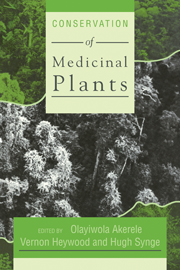Book contents
- Frontmatter
- Contents
- Contributors
- Preface
- Acknowledgements
- The Chiang Mai Declaration
- Introduction
- The Issue of Medicinal Plants
- 3 Global Importance of Medicinal Plants
- 4 Traditional Knowledge of Medicinal Plants – the Search for New Jungle Medicines
- 5 The Reason for Ethnobotanical Conservation
- Science, Industry and Medicinal Plants
- Techniques to Conserve Medicinal Plants
- Policies to Conserve Medicinal Plants
- Experiences from Programmes to Conserve Medicinal Plants
3 - Global Importance of Medicinal Plants
Published online by Cambridge University Press: 07 September 2010
- Frontmatter
- Contents
- Contributors
- Preface
- Acknowledgements
- The Chiang Mai Declaration
- Introduction
- The Issue of Medicinal Plants
- 3 Global Importance of Medicinal Plants
- 4 Traditional Knowledge of Medicinal Plants – the Search for New Jungle Medicines
- 5 The Reason for Ethnobotanical Conservation
- Science, Industry and Medicinal Plants
- Techniques to Conserve Medicinal Plants
- Policies to Conserve Medicinal Plants
- Experiences from Programmes to Conserve Medicinal Plants
Summary
Introduction
Ancient Man is known to have utilized plants as drugs for millennia. Based on current knowledge, at least in the West, we know that extracts of some of these plants are useful in a crude form, i.e. Atropa belladonna Tincture as an antispasmodic, Rauvolfia serpentina roots for hypertension and as a tranquilizer, Papaver somniferum extract or tincture as an analgesic, etc. Further, we know that at least 121 chemical substances of known structure are still extracted from plants that are useful as drugs throughout the world (Anon, 1982a). A large number of plants are used in traditional medical practices, and have been for more than 3000 years, such as in Chinese Traditional Medicine, Ayurvedic Medicine, Unani Medicine, etc., most of which probably exert therapeutic effects and would be proven as such if they were properly evaluated by Western standards. Still further, plants have been employed for centuries by primitive cultures; most of these are less likely to pass the test of modern experimental verification of efficacy. Finally, there are a large number of so-called herbal remedies, mainly sold in health food stores in developed countries, many of which remain to be verified for their real therapeutic effects.
Several years ago the World Health Organization made an attempt to identify all medicinal plants that exist in the world. It was admitted that the compilation of names of medicinal plants undoubtedly contained many replicates since botanical verification was not attempted. Further, the list only provided Latin binomials and the countries where the plants were used, but excluded data indicating what the plants were used for. More than 20,000 species were included on this list.
- Type
- Chapter
- Information
- Conservation of Medicinal Plants , pp. 25 - 52Publisher: Cambridge University PressPrint publication year: 1991
- 128
- Cited by



